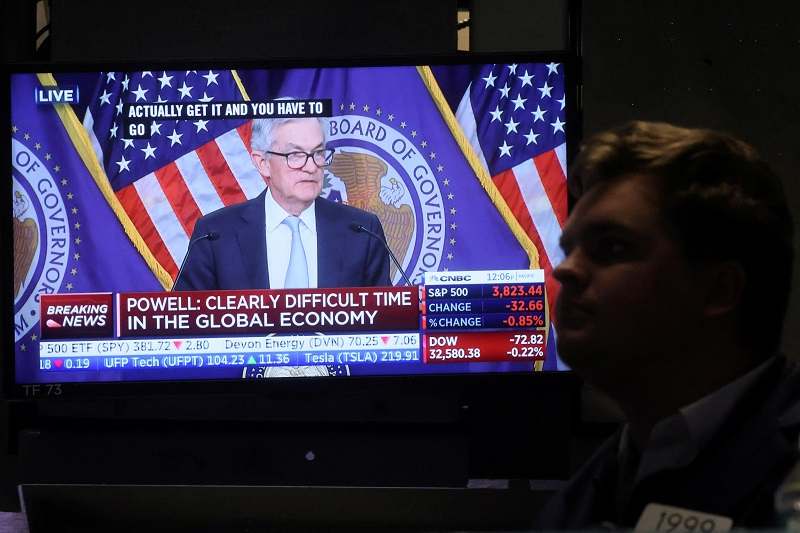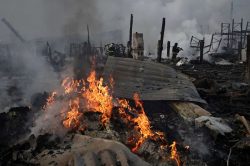
A screen displays Federal Reserve Chair Jerome Powell speaking as a trader works on the floor of the New York Stock Exchange (NYSE) in New York City on Wednesday.
9:02 JST, November 3, 2022
WASHINGTON, Nov 2 (Reuters) – The Federal Reserve raised interest rates by three-quarters of a percentage point again on Wednesday and said its battle against inflation will require borrowing costs to rise further, yet signaled it may be nearing an inflection point in what has become the swiftest tightening of U.S. monetary policy in 40 years.
The double-sided message left open the possibility the U.S. central bank may raise rates in smaller increments in the future, ending its sequence of three-quarters-of-a-percentage-point hikes as soon as December in favor of more tempered increases of perhaps half a percentage point, while also leaving policymakers room to continue pushing rates higher if inflation doesn’t start to slow.
Fed Chair Jerome Powell, speaking in a news conference after the end of the central bank’s latest policy meeting, said he wanted no confusion on that point: Even if policymakers do scale back future increases, he said, they were still undecided about just how high rates would need to rise to curb inflation, and were determined to “stay the course until the job’s done.”
Regardless of how fast the Fed moves, “there’s some ground to cover” for the target federal funds rate to reach a “sufficiently restrictive” level that will slow inflation, Powell said. The final destination is “very uncertain … We’re going to find it over time.”
“The question of when to moderate the pace of increases is much less important than the question of how high … and how long to keep monetary policy restrictive,” he said, adding that it was “very premature” to discuss when the Fed might pause its increases.
Major U.S. stock indices spiked after the release of the Fed’s statement, which promised to take economic risks more clearly into account in deciding the size of any further rate increases, but erased those gains as Powell spoke and ended the day sharply lower. The S&P 500 index .SPX fell 2.5% and the Nasdaq Composite .IXIC slid more than 3%.
Yields on U.S. Treasury securities, which had dropped sharply after the Fed statement was released, turned higher. The 2-year note US2YT=RR – the bond maturity most sensitive to Fed policy expectations – was up 6 basis points to about 4.61%.
Bill Nelson, a former top Fed staffer who is now chief economist at the Bank Policy Institute, said ahead of Powell’s news conference that the Fed’s policy statement appeared to set the central bank up for more rate hikes before its tightening cycle is completed, delivered at a possibly slower pace.
The document “implied that (the Fed) may be aiming for a higher medium-term level for the fed funds rate than currently expected,” Nelson said.
Investors were expecting a signal the Fed might ease up on its pace of tightening after a blistering run that raised the policy rate from near zero in March to what is now a range of between 3.75% and 4.00% – the fastest monetary tightening since the early 1980s.
The pace of the rate hikes has triggered global anxiety the Fed was dragging the world economy towards a point of no return, with the dollar’s strength against major currencies in effect exporting U.S. inflation and stressing finiancial markets from London to Tokyo.
The Fed’s statement broadly acknowledged the need to assess the affect of the policy moves made so far in calibrating any future decisions.
“Ongoing increases in the target range will be appropriate,” the central bank’s policy-setting Federal Open Market Committee said at the end of its two-day meeting. But “in determining the pace of future increases in the target range, the Committee will take into account the cumulative tightening of monetary policy, the lags with which monetary policy affects economic activity and inflation, and economic and financial developments.”
The time to reassess the pace of increases “is coming,” Powell said. “It may come as soon as the next meeting or the one after that … No decision has been made.”
The language in the policy statement acknowledged the broad debate that has emerged around the Fed’s policy tightening, and opened a new stage in that discussion.
While the rapid increases this year have been done in the name of moving “expeditiously” to catch up with inflation running at more than three times the Fed’s 2% target, the central bank is now entering a more nuanced phase – fine-tuning instead of “front-loading.”
At the Fed’s Sept. 20-21 meeting, the median estimate among policymakers pegged the peak fed funds rate next year at between 4.50% and 4.75%. Rate futures markets now imply about even odds of it climbing to 5% or higher next year.
The shift in the FOMC statement “took me a little by surprise,” said Derek Tang, an economist with forecasting firm LH Meyer. The Fed’s statement “was a lot more definite about a possible downshift than I thought it would be. I thought (Powell) would reserve a lot more judgment until December, but it seems like the Committee did reach a consensus that they could downshift as early as December, depending on how the data go.”
"News Services" POPULAR ARTICLE
-

American Playwright Jeremy O. Harris Arrested in Japan on Alleged Drug Smuggling
-

Japan’s Nikkei Stock Average as JGB Yields, Yen Rise on Rate-Hike Bets
-

Japan’s Nikkei Stock Average Licks Wounds after Selloff Sparked by BOJ Hike Bets (UPDATE 1)
-

Japan’s Nikkei Stock Average Buoyed by Stable Yen; SoftBank’s Slide Caps Gains (UPDATE 1)
-

Japanese Bond Yields Zoom, Stocks Slide as Rate Hike Looms
JN ACCESS RANKING
-

Keidanren Chairman Yoshinobu Tsutsui Visits Kashiwazaki-Kariwa Nuclear Power Plant; Inspects New Emergency Safety System
-

Imports of Rare Earths from China Facing Delays, May Be Caused by Deterioration of Japan-China Relations
-

University of Tokyo Professor Discusses Japanese Economic Security in Interview Ahead of Forum
-

Japan Pulls out of Vietnam Nuclear Project, Complicating Hanoi’s Power Plans
-

Govt Aims to Expand NISA Program Lineup, Abolish Age Restriction























